How to Get Steam Stains Out of a Wood Table
Building tables is one of my favorite DIY furniture projects to do. I love creating a space for people to gather and share a meal together. However, the flip side to heavy use of a table is that the wood can occasionally get damaged through steam stains.
To find the best way to remove a steam stain from a wood table, I collected every home remedy I could find. I tried every method of removing steam stains on a piece of wood that I intentionally added steam stains and water stains to. Some methods worked very well, some discolored the wood, and some methods did not work at all.
Today, I’m going to outline my experiment for you so you can find the best way to remove that white, hazy ring left by heat on wooden furniture from steam
The Best Ways to Get Steam Stains Out of a Wood Table
I tested out 9 different methods for removing white heat stains and I will go into detail on each method. However, let’s jump ahead and talk about what you came here for.
The best way I found to get white heat marks out of wood is by using an iron and a water mark remover cloth. These particular methods gave me the best results, however, a few methods came in a close second.
In the picture below, you can see the original piece of wood. In the next picture, just the bottom half was ironed and you can see how the steam stains were removed. Note: the watermarks across the board in the second picture dried and didn’t leave a mark from the iron.
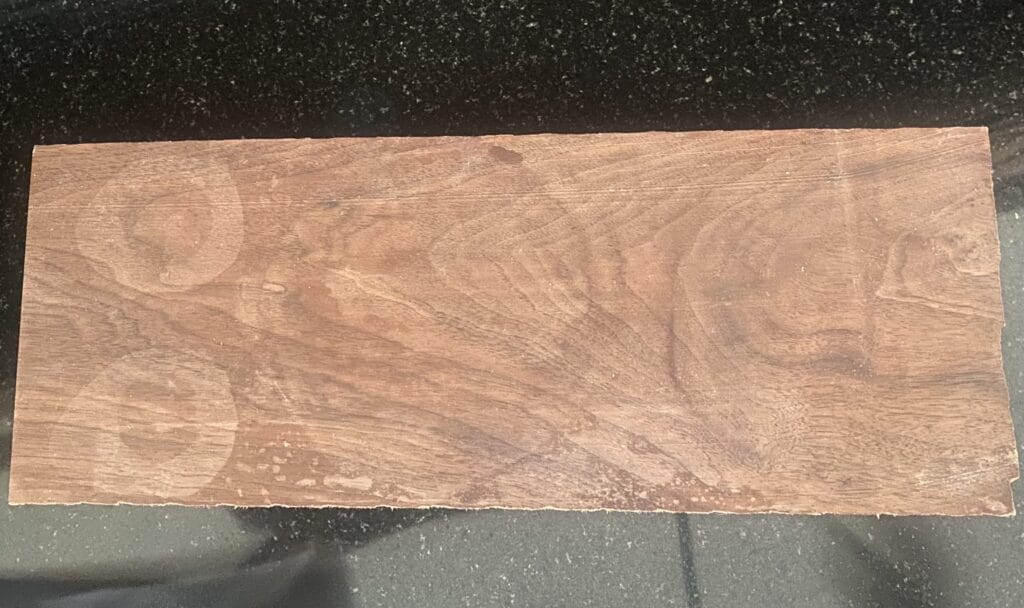
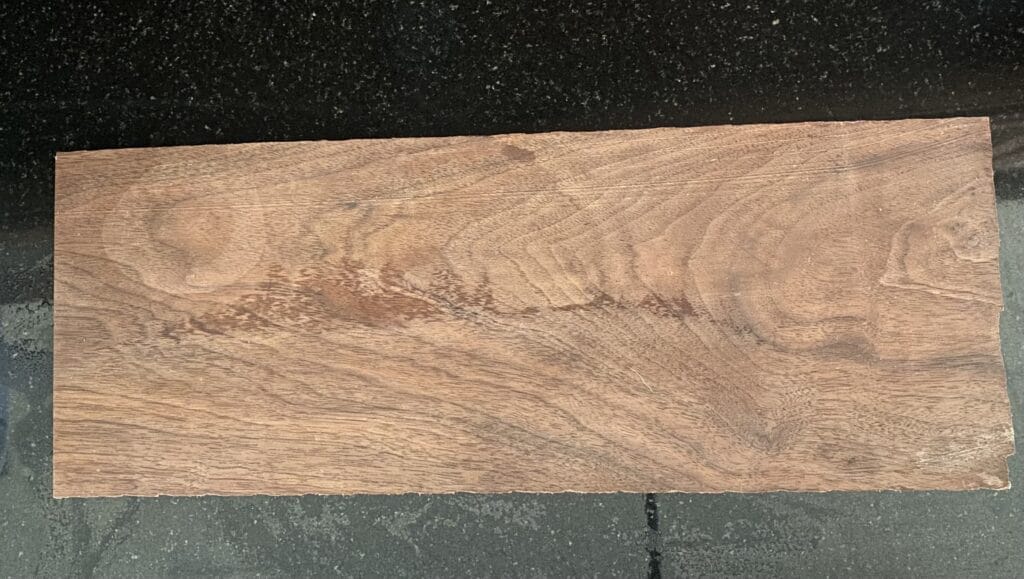
I should note that this experiment was done on a piece of walnut wood that was sealed with lacquer. Every table is made and sealed differently, so it’s important to test out your method of choice on an inconspicuous spot on the table. These were my results for my table and they will give you a great starting point. But, I encourage you to find the method that works best for your table.
Methods Tested for Getting a Steam Stain Out of a Wood Table
The methods I tested out are:
- Steamer
- Hair Dryer
- Iron
- 2:1 Baking Soda to Toothpaste Mixture
- Mayonnaise
- Petroleum Jelly
- 1:1 Vinegar to Olive Oil Mixture
- 1:1 Salt to Olive Oil Mixture
- Guardsman Water Mark Remover Cloth
Experimenting Ways to Remove Heat Stains
I will now explain the details of each method and whether they worked or not.
Steamer
Details
I held a steamer very close to the affected area for 2 minutes, then wipes off the excess moisture with a microfiber cloth. Although this method seems counterintuitive, it actually makes sense. The moisture was trapped in the wood because the heat open the wood pores and allowed the moisture in. So, it makes sense that heat lets the moisture out as well.
Result
No change in the steam stain.
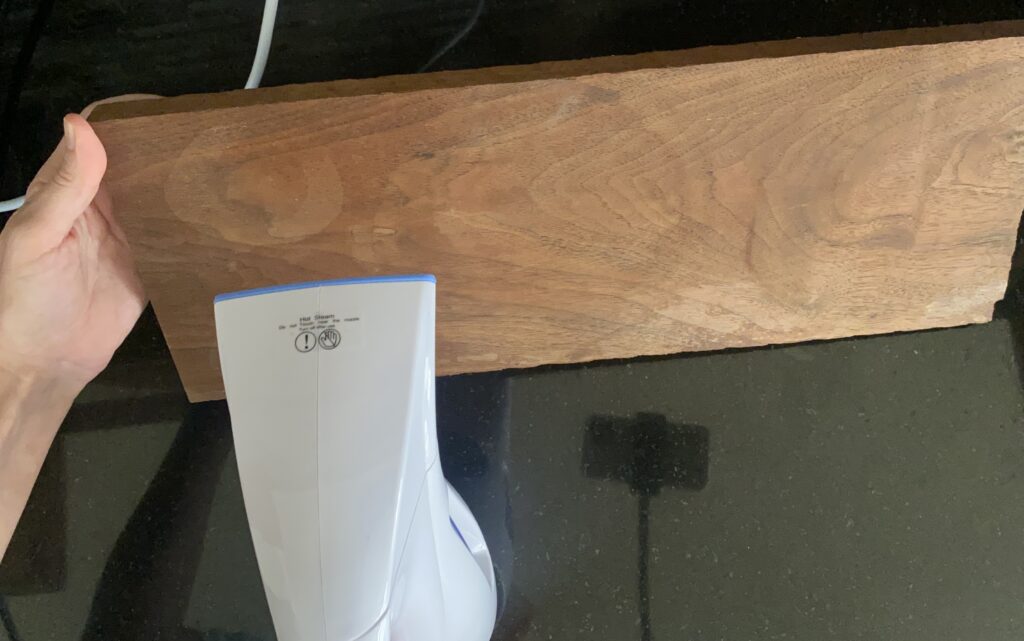
Hair Dryer
Details
This method is similar to the steamer method, however, it is just the heat, minus the moisture from steam.
Result
No change in the wood. If I had held the hair dryer there for longer, it might have. However, the iron method was much quicker to achieve this
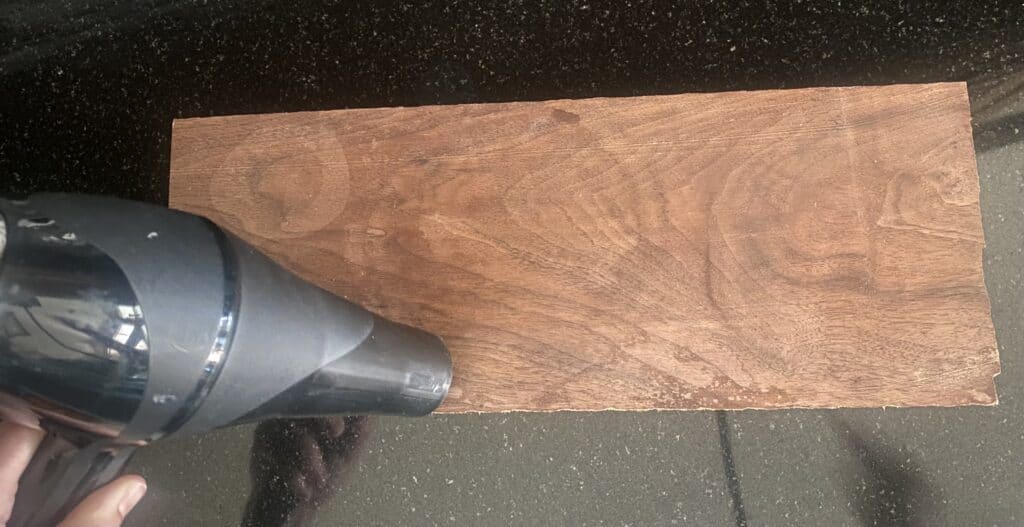
Iron
Details
This iron method is a step up on the heat scale from the hair dryer. It might be a great option if the steam ring is large and the hair dryer doesn’t work.
I put a thin pillowcase over the wood and ironed it on a high setting for about 3 minutes. To test this out on your table, start with low heat and see how the finish on your table responds.
Result
Great results. It completely removed the steam stain and the water stain left from condensation from a glass of water.
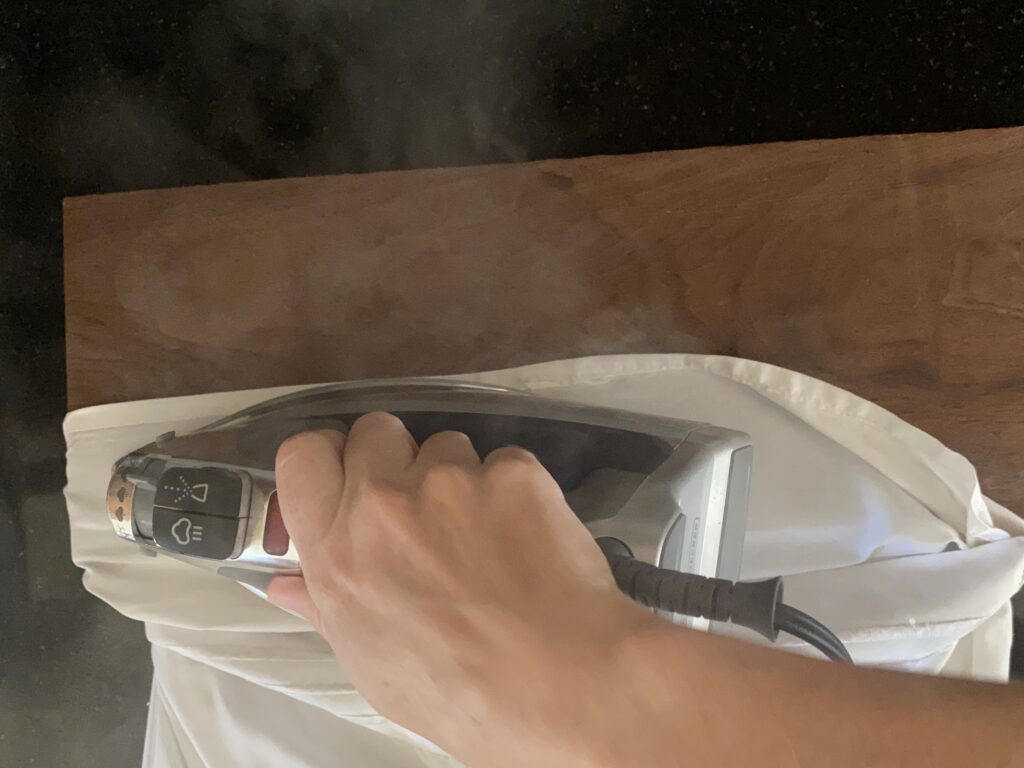
1:2 Regular Toothpaste to Baking Soda Mixture
Details
The toothpaste for this method needs to be plain white toothpaste, not a gel toothpaste. Baking soda is a common ingredient in toothpaste, however, you will add more as an effective way of removing trapped moisture from the steam stain.
Leave it on the surface for 10 minutes. You can wipe it off with a damp cloth, but be sure to dry the area.
Result
I’ve read that many people have great results with this, however, the only change to my piece was discoloration in the wood. I do not recommend this method. However, if you try it, start with an inconspicuous area first.
The picture below shows the next 4 methods as well.
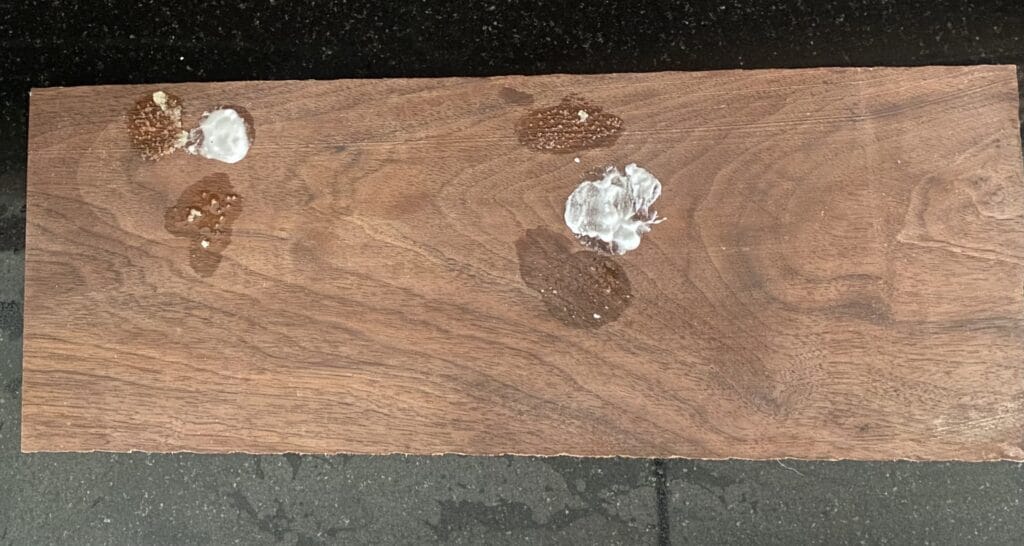
Mayonnaise
Details
Yes, it sounds a little weird to rub mayonnaise into your piece of furniture to remove the white stains. However, mayonnaise is oil-rich, which will soak into the wood and hopefully release the moisture.
Allow it to sit on the wood for 2 hours, then wipe it with a clean cloth in a circular motion. You can then clean the area with furniture polish.
Result
There was no change in the heat stain.
Petroleum Jelly
Details
This is an alternative to mayonnaise. Being that petroleum jelly is also a thick oil, the wood will absorb it and release the steam stain.
Let it sit on the wood table for 2 hours.
Result
It did remove the steam stain, however, it discolored the wood.
1:1 Vinegar to Olive Oil Mixture
Details
White vinegar is a great cleaning tool around the house for descaling hard water spots. Therefore, it makes sense that this would be effective in removing a steam stain caused by moisture.
I left this on for 20 minutes.
Result
It did remove the water stain, however, it discolored the wood.
1:1 Salt to Olive Oil Mixture
Details
Salt can eat away at surfaces and is effective in scrubbing surfaces for cleaning. Allow it to sit on the wood for 20 minutes
Result
No change in the wood.
Guardsman WaterMark Remover Cloth
Details
Guardsman Watermark Remover Cloth is technically just for water stains left from condensation from a glass that was left on the wood surface for an extended amount of time. However, the instructions include heat stains in the list of things it can remove.
Scrub the water ring with a soft cloth until the marks disappear.
Result
This worked great to remove a water stain from a table, however, it was not effective in removing a steam stain. This cloth does have oil in it, so it might discolor your piece if it does not have a thicker sealer on it.
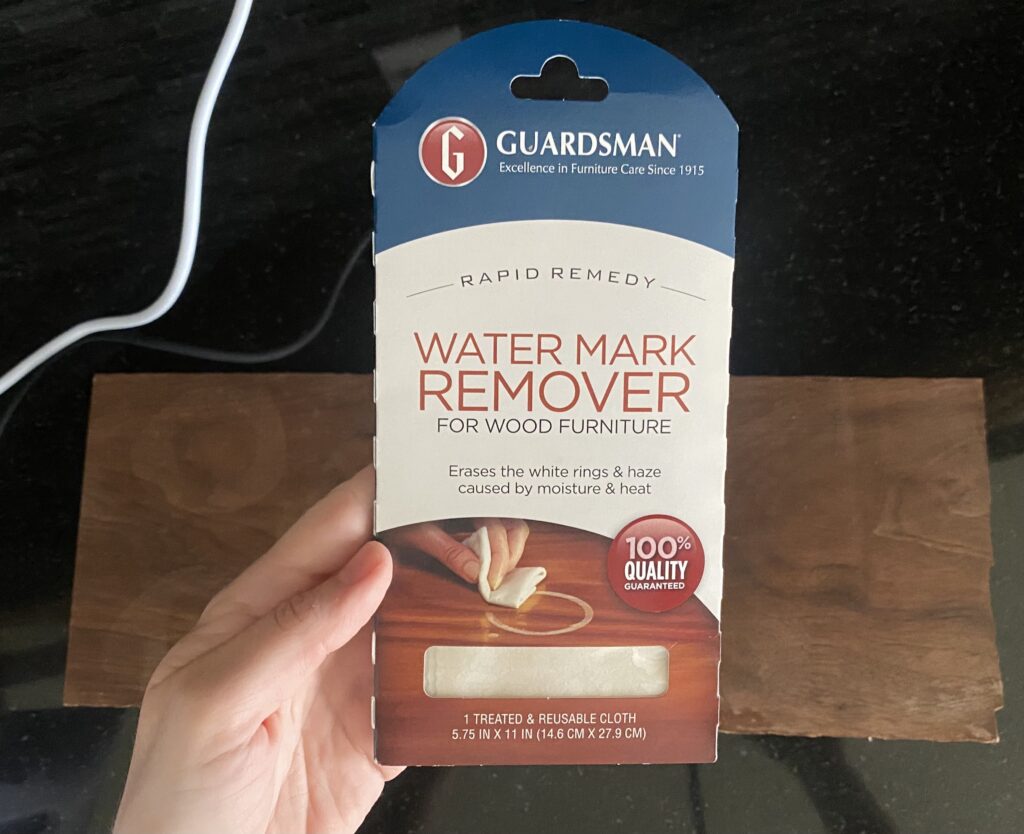
How Steam Marks on Wooden Tables Occur
When a hot pan, serving plate, hot cup of coffee on a side table, hot pizza box, or pot is set on a wooden table, white marks will oftentimes be left on wood furniture. The good news is that the cloudiness can somewhat easily be removed with just a little work.
The heat from the hot item opens the pores on the wooden surface and allows moisture to settle in the wood grain on the table. Once cooled, the wood pores close and essentially seal in the heat. So, every method I tested is essentially attempting to remove moisture rings from dining tables.
Steam Stain vs. Water Mark vs. Burn Mark
Steam stains are formed from heat allowing moisture in the wood grain. Water marks occur when water is left on a wood table and the wood absorbs the moisture. So, these two stains are very similar in that they are both effects of the wood holding moisture, creating white rings.
If something very hot, like a cast iron lid is set on a wood table, it can leave a brown mark or charred, black stains. This is not a steam stain, as it is not caused by moisture. Instead, it is caused by the surface of the wood being burned. Therefore, none of these methods would be effective in removing that kind of mark off of a table.
If a burn marks does occur on your table, the best option might be to sand the surface of the whole table and refinish it. I outline the best finish for a wood kitchen table in this post. You will find that article helpful if you find yourself needing to refinish a kitchen table due to burn marks.
How to Prevent Steam Stains from a Wood Table
The easiest way to prevent a steam stain from a table is to avoid putting any hot items on the table in the first place. Set multiple trivets out when food will be passed around the table, so that no one accidentally puts a hot pan directly on the table.
If you don’t own a trivet, use a tablecloth or placemats to prevent white spots from occurring on the table. Protect that beautiful wood dining table!
Always Test Out a Small Section
All of these methods were experimented on a piece of walnut that was sealed with an oil-based lacquer. However, not every table is finished in the same way. Test out the method on an inconspicuous part of the table, just in case your wood dining table reacts differently.
For more cleaning tips, check out this post on the best non toxic rust remover product and how to remove rust from concrete.

Suzie Wible
Suzie has shared her knowledge for over 10 years about building furniture, painting techniques, how to build your dream home, and basic to advanced woodworking skills. Through this blog, readers will feel empowered to create a home and products they love too.